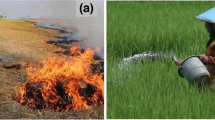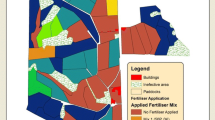Abstract
When semidwarf, fertilizer-responsive varieties became available in the late 1960s, a range of policy and institutional changes were also introduced to exploit the potential of these varieties. As a result, adoption of both high-yielding varieties and chemical fertilizers increased rapidly, especially in irrigated areas. A review of how these policy and institutional changes have influenced adoption of chemical fertilizers is presented using a microeconomic model of technology adoption. It is argued that fine-tuning of these policy and institutional innovations will continue to be important in further increasing rice yields and farmers' incomes, especially in rainfed areas where fertilizer use is still very low. In the more intensive irrigated areas, where chemical fertilizer use is already high, a change in the paradigm from that of encouraging higher input use to achieving increased input-use efficiency is suggested. Based on a conceptual model of the likely evolution of the nature of rice production systems in Asia, a somewhat targeted approach to the design of technological, policy, and institutional interventions for improving farmers' nutrient management practices is recommended.
Similar content being viewed by others
References
Adams D, Graham D & von Pischke J (1984) Undermining Rural Development with Cheap Credit. Westview, Boulder
Ali M & Narciso JH (1994) Economic evaluation and farmers' perception of green manure use in rice-based farming systems. In: Ladha JK & Garrity DP (eds) Green Manure Production Systems for Asian Ricelands. Selected papers from the International Rice Research Conference. International Rice Research Institute (IRRI), Los Banos, Laguna, Philippines
Ali M & Byerlee D (1991) Economic efficiency of small farmers in a changing world: A survey of recent evidence. J Int Develop 3(1): 1–27
Anderson JR & Hazell PBR (1994) Risk considerations in the design and transfer of agricultural technology. In: Anderson JR (ed) Agricultural Technology: Policy Issues for International Community, Chapter 18, pp 321–339. CAB International, UK
Anderson JR, Herdt RW & Scobie GM (1985) The contribution of agricultural research to world agriculture. Am J Agricul Econ 67(5): 1080–1084
Anderson JR, Dillon JL & Hardaker B (1977) Agricultural Decison Analysis. Iowa State University Press
Antle JM & Crissman CC (1990) Risk, Efficiency, and the Adoption of Modern Crop Varieties: Evidence from the Philippines, Economic Development and Cultural Change. Vol 38No 3 pp 517–537
Avnimelech Y (1986) Organic residues in modern agriculture. In: Chen Y & Avnimelech Y (eds) The Role of Organic Matter in Modern Agriculture pp 1–10. Martinus Nijhoff Publishers, Dordrecht
Becker M, Ladha JK & Ottow JCG (1994) Nitrogen losses and lowland rice yield as affected by residue nitrogen release. Soil Sci Am J 58:1660–1665
Boserup E (1965) The Conditions of Agricultural Growth. Allen & Unwin, London
Boserup E (1981) Population and Technological Change: A Study of Long-Term Trends. University of Chicago Press, Chicago
Byerlee D (1994) Technology transfer systems for improved crop management: lessons for the future. In: Anderson JR (ed) Agricultural Technology: Policy Issues for the International Community, Chapter 12, pp 208–230. CAB International, UK
Byerlee D & Hesse de Polanco E (1986) Farmers' stepwise adoption of technological packages: Evidence from the Mexican altiplano. Am J Agricul Econ 68(3): 519–27
Dalrymple DG (1986) Development and Spread of High-Yielding Rice Varieties in Developing Countries, Bureau for Science and Technology, USAID, Washington DC
David CC & Otsuka K (1994) Modern Rice Technology and Income Distribution in Asia, Lynne Rienner Publishers, Inc., Colorado and London
Desai GM (1989) Policy for rapid growth in use of modern agricultural inputs. In: Mellow JM & Ahmed R (eds) Agricultural Price Policy for Developing Countries, Chapter 12, pp 204–218. The Johns Hopkins University Press, Baltimore and London
Feder GR, Just E & Zilberman D (1985) Adoption of Agricultural Innovations in Developing Countries: A Survey Economic Development and Cultural Change 33:255–298
Flinn JC & Marciano VP (1984) Rice straw and stubble management. In: Organic Matter and Rice, pp 593–612. International Rice Research Institute
Garrity DP & Flinn JC (1987) Farm-level Management Systems for Green Manure Crops in Asian Rice Environments. In: Sustainable Agriculture: Green Manure in Rice Farming. International Rice Research Institute, Los Banos, Philippines
Griffin K (1974) The Political Economy of Agrarian Change: An Essay on the Green Revolution. Harvard University Press, Cambridge
Hossain M & Fischer KS (1995) Rice research for food security and sustainable agricultural development in Asia: Achievements and future challenges. GeoJournal 3:286–298
Hossain M & Laborte A (1994) Differential growth in rice production in Eastern India: agroecological and socioeconomic constraints, Social Sciences Division, IRRI
Kanazawa N (1984) Trends and economic factors affecting organic manure in Japan. In: Organic Matter and Rice, pp 557–568. International Rice Research Institute
Mellor JW & Ahmed R (1989) Agricultural Price Policy for Developing Countries. The Johns Hopkins University Press, Baltimore and London
Pandey S (1996) Rainfed Lowland Rice Research: Challenges and Priorities for the 21st Century. Social Sciences Division, International Rice Research Institute, Los Banos, Laguna, Philippines
Pandey S, Masicat P, Velasco L & Villano R (1997) Risk analysis of rainfed rice production systems in Tarlac, Central Luzon, Social Sciences Division, International Rice Research Institute, Los Banos, Laguna, Philippines
Pignali PL (1995) Crop-livestock systems for tomorrow's Asia: from integration to specialization. In: Devendra C & Sevilla C (eds) Crop Animal Interaction pp 481–500. International Rice Research Institute
Pingali PL, Hossain M, Pandey S & Price L (1997) Determinants of Farmer Adoption of Knowledge Intensive Nutrient Management Technologies, Field Crops Research (forthcoming)
Rosegrant MW & Roumasset JA (1987) Economic feasibility of green manure in rice-based cropping systems. In: Sustainable Agriculture: Green Manure in Rice Farming. International Rice Research Institute, Los Banos, Philippines
Rosegrant MW & Svendsen (1992) Irrigation investment and management in Asia. Paper presented at the IRRI-IFPRI Planning Workshop on Rice Supply and Demand Project. International Rice Research Institute (IRRI), Los Banos, Laguna, Philippines
Roumasset JA, Rosegrant MW, Chakravorty UN & Anderson JR (1989) Fertilizer and crop yield variability: a review. In: Anderson JR & Hazell PB (eds) Variability in Grain Yields: Implications for Agricultural Research and Policy in Developing Countries, John Hopkins University Press
Ryan J & Subramanian KV (1975) Package of practice's approach in adoption of high-yielding varieties: An appraisal. Economic and Political Weekly 10(4): A101–10
Singh Y, Khind CS & Singh B (1991) Efficient Management of Leguminous Green Manures in Wetland Rice. Adv Agron 45:135–189
Tomich TP, Kilby P & Johnston BF (1995) Transforming Agrarian Economies: Opportunities Seized, Opportunities Missed, Cornell University Press, Ithaca and London
Author information
Authors and Affiliations
Rights and permissions
About this article
Cite this article
Pandey, S. Adoption of nutrient management technologies for rice production: economic and institutional constraints and opportunities. Nutrient Cycling in Agroecosystems 53, 103–112 (1998). https://doi.org/10.1023/A:1009701906501
Issue Date:
DOI: https://doi.org/10.1023/A:1009701906501




